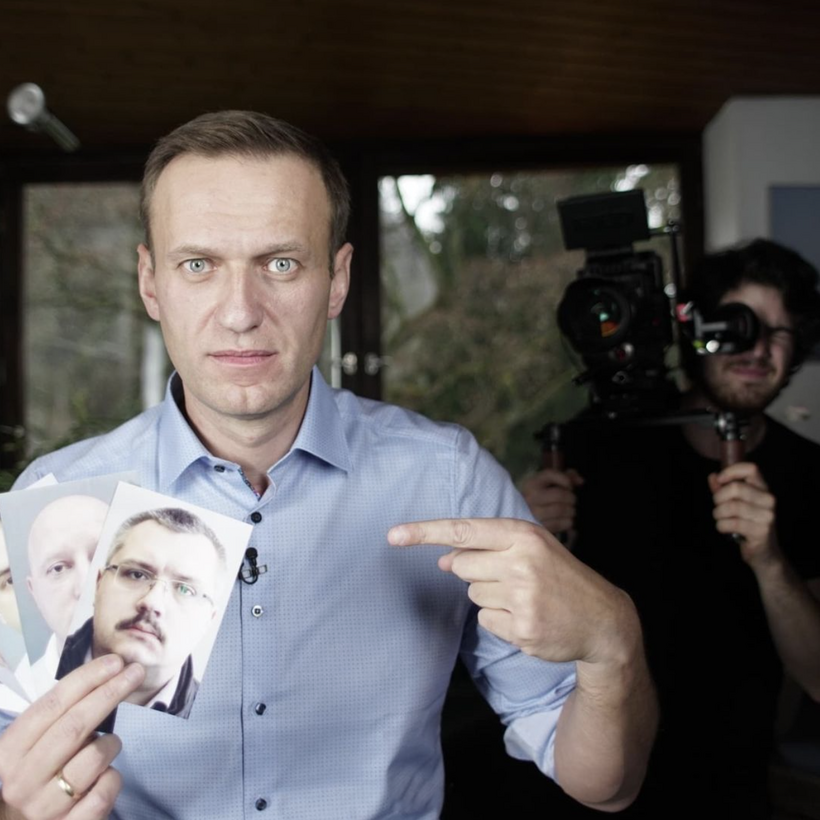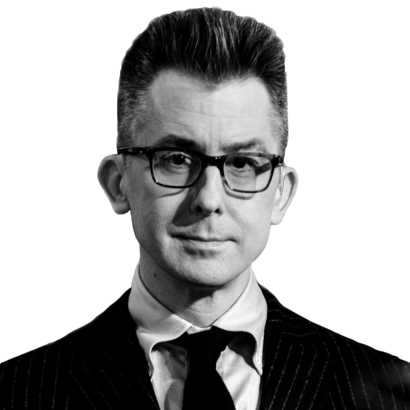No political documentary that has come out this year is as riveting and at times darkly humorous as Navalny. The film, which has been nominated for an Academy Award for Best Documentary, is an intimate and revealing portrait of Alexei Navalny, the 46-year-old journalist turned Russian-opposition leader who survived a poisoning by Russian operatives and is now in solitary confinement in a Siberian gulag. It allows viewers to witness why its subject is such a transformative—and, for Putin, dangerous—force in Russian politics.
It’s a film filled with surprises—not least its director, Daniel Roher. A charming, disarming 30-year-old Canadian with a bushy head of hair, stubble on his face, and round-framed glasses, who prior to this had made only one feature-length documentary (about Robbie Robertson and the Band), the relatively unknown Roher beat out bigger-name directors with much bigger budgets who had been chasing Navalny. Alexei’s choosing him was, Roher admits to me as we meet up for coffee at Sarabeth’s on Central Park South, “unusual.”

But then Roher is unusual in a number of ways. No sooner have we sat down than he reaches into his coat pocket and pulls out a tray of portable watercolor paints, a brush, and a small sketchbook.
“Don’t mind me,” he says, as he flips open the paint tray, dips his brush into a glass of water, and starts to paint a portrait of me on the tabletop’s paper liner. “I have A.D.D.,” he tells me. “I have trouble sitting still, so I always have to be making stuff.”
He then nudges the sketchbook toward my hands, and when I open it I find it brimming with faces, still lifes, stolen moments—lovely and mesmerizing images as well as diaristic observations.
“That’s book No. 132. I’ve been carrying one of those books since I was 14. Taken together, they end up being a sort of visual index of the things that have happened to me. It’s all part of a project I call ‘Draw Everything Always All the Time.’ And when I die, hopefully there will be a thousand of them or something, and then the Library of Canada or whoever will inherit them and have to figure out what to do with them.”

He pauses, and I notice he’s focused on my hands, quickly rendering them on the paper.
“Drawing and painting works for me as a social crutch. I have a little bit of social anxiety. And so long as I can make something, I am happy,” Roher says. “But, really, I see that these books are mini-documentaries of each day. Of moments.”

As he speaks, I linger over a page filled with images of maybe 30 or 40 people. “Airport people,” he says. “I like to sketch people in airports. You have six seconds to get an impression of someone down on paper. Airports are a lot of my life these days, ever since Navalny. Being on the road to discuss it, and to keep Alexei present in conversations.” He pauses. “Everything’s so different now.”
Before Navalny, Roher’s life was quite ordinary. “I grew up in Toronto. My parents were in the clothing business, the schmatte business. But ever since I was a kid, I was interested in art, and my mom and dad totally supported that dream.”
Roher started making short films in high school and enrolled in Savannah College of Art and Design, but quickly dropped out. (“I get restless in classrooms,” he says.) He bought a movie camera and started to shoot and edit on his own, teaching himself. “You’d be amazed how many YouTube tutorials are out there!” he says.
Is it unusual, I ask him, that someone with A.D.D. and social anxiety would choose to make documentaries—where so much depends on interacting with the subject, with strangers?
“Not really,” Roher says. “Making a movie is all about focusing on subjects and tasks, so that process works for me. And also, if you are a nice, friendly human being, people enjoy spending time around you.”
In 2019, Roher had been working on a film that fell apart in the early days of the coronavirus lockdown. While he was trying to figure out what to do, one of the producers he was working with, Odessa Rae, got a call from a journalist named Christo Grozev, who works for Bellingcat, the international-investigative-journalism site. Grozev told Rae he had evidence that linked the Kremlin to Navalny’s poisoning. A few days later, Roher, Rae, and Grozev met with Navalny to pitch the idea of doing a film that would reveal Putin’s complicity in the plot, and also document Navalny’s work as an opposition figure.

“Alexei was skeptical at first,” Roher says. “In a lot of ways, he didn’t need to do a movie. He is a master of social media and getting his message out on those channels. But I told him, ‘Social media vanishes, and a film lives. It can keep your name in the headlines.’ Maybe he liked my chutzpah?”
I nod toward the painting of me that is now emerging.
“Did you paint in your first meeting with Navalny?”
“I did.”
“And what did he say?”
“I remember he kind of eyed what I was doing. And he said, ‘Daniel, what is it with the sketchbook?’ And I told him right away, ‘I have A.D.D. This is what helps me focus.’ And then he said, ‘Oh, it’s so nice we’ve hired a director with special needs.’ We both laughed. From the first moment, that was our relationship. Taking the piss out of each other.”
“He didn’t need to do a movie. He is a master of social media and getting his message out on those channels. But I told him, ‘Social media vanishes, and a film lives.’”
He laughs. But in many ways, the film, the relationship Roher forged with Navalny, and what Navalny’s life has now become in the past few months, all of it mixes together to haunt Roher.
“Making something so vital and important is the dream of any filmmaker. But I have nightmares every single night. It’s a dream where I’m running through little villages looking for Alexei, and I can’t find him, and there’s this driving anxiety if I don’t find him he’ll be murdered. He’s been in solitary for three months now, because of his anti-war advocacy. It’s winter. They won’t let him have shoes. He’s in a nine-foot-by-six-foot cell. He gets one book every two weeks.”

Roher pauses and spins his brush into one of his paint kit’s small cells, then adds a streak of blue to the portrait.
“My personal success is bittersweet. It means nothing because he’s not here. But I know the success of the film is that it keeps his name alive and his story alive in the world. Putin likes to use murder to solve problems. I hope this film takes away that solution.”
He looks up from the painting now, considers it. As he does, I ask, “How would you describe Alexei in three words?”
Roher pulls out a pen, and in the margin of the painting writes in black ink: “Smart-Ass Brave Politician.”
Michael Hainey is a Writer at Large for AIR MAIL

